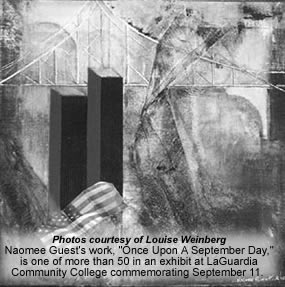After the events
of September 11, artists across the city were recorded in interviews
questioning the value of their trade. Some said the magnitude of
the horror of the tragedy was too great for art to encompass, while
others argued that such terrible circumstances demanded a kind of
practical action that art could not deliver.
Over the past year,
however, artists from New York and across the country slowly but
surely began creating again as a way to heal themselves and reach
out to others.
An exhibit of digital
images of some of those works, curated by Long Island City artist
Louise Weinberg and techno-artist Kenny Greenberg, will open today
at LaGuardia Community College. The show is called Mnemonic: a
9/11 Memorial Exhibition, and each work offers a different way
of remembering the tragedy.
"In some way, this
exhibit is providing a focus for the process of communicating,"
Weinberg explained. "Art is about communicating. If someone gets
solace by looking at something, that helps them move forward a little
bit. Art at its best can help people identify and not feel alone."
The works include
a painting by Roxana Alger Geffen that depicts the funeral of her
father, who died at the World Trade Center.
Another work is
an oil painting created in 2000 by Dennis D’Amelio of the view
from his studio on the 91st floor of the Trade Center.
In one simple collage,
Elizabeth Riley of Manhattan has placed a printout of a September
9 email from a colleague’s husband-—in which he explains the origins
of some ties he donated for one of her projects—on some of the
ties with a photograph of him. The man died on September 11.
Artists from places
as disparate as Scotland, Japan, Australia, Tennessee and New Jersey
entered pieces in the exhibit, along with the many New Yorkers
who participated.
Weinberg said many
of the artists she had spoken with said they had felt frozen after
September 11, but that by now they had found time to process the
events and could channel their emotions creatively again.
"Art can help artists
cope with this [event]," Weinberg said. "And it can help other
people cope through recognition of an expression of something inexpressible."
Weinberg said she,
too, felt frozen after September 11.
"I stood in my living
room and watched the towers go down," she said. "I cried for months.
To me it was like losing someone in my family."
It took nearly a
month before she could address the events through art.
"I made my first
trip [to ground zero] on October 6," she said. She returned over
and over again to photograph what she saw. "It became a mission
for me," she said.
She took pictures
of firehouses, dust-laden stores and memorials left to the dead.
Weinberg compared
the sense of purpose she gained in photographing the aftermath to
the powerlessness she experienced on a practical level.
"We felt helpless
as New Yorkers," she said. "I tried to bring socks down [to the
rescue workers], but they already had a thousand pairs. I tried to
give blood but they didn’t need me."
She said the artists
who responded to her call for 9/11-related work have expressed
similar feelings.


